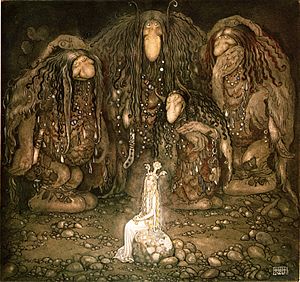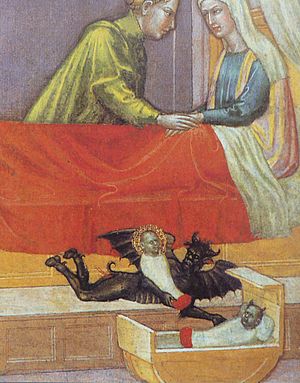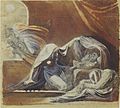Changeling facts for kids
A changeling is a creature from old stories and folklore. People used to believe that a changeling was a fairy child secretly left in place of a human child that had been stolen by fairies. This idea of a swapped child appears in many old tales. It often showed worries about babies who had strange illnesses or didn't develop normally.
Contents
What is a Changeling?
A changeling is usually described as the baby of a fairy, elf, or other legendary creature. This fairy baby would be secretly left in a human home, replacing a human child. Sometimes, the word "changeling" also refers to the human child who was taken away.
In some stories, the changeling wasn't even a real creature. It could be a stock or fetch. This was an enchanted piece of wood that looked like a baby but would soon get sick and die.
People thought human children might be taken for different reasons. Fairies might want them as helpers, or they might simply love human children. Sometimes, it was just out of mischief. It was most often believed that fairies were the ones doing the swapping. In rare cases, a very old fairy might be swapped for a human baby. This way, the old fairy could live a comfortable life, being cared for by human parents.
People tried to protect their babies from changelings. Simple charms, like turning a coat inside out or leaving open iron scissors near where the child slept, were thought to keep them away. Keeping a constant watch over the child was another way to try and prevent a swap.
Why Fairies Swapped Children
There were many beliefs about why fairies might swap children.
- Some thought that trolls believed it was better for their children to be raised by humans. They wanted their own babies to have a human upbringing.
- Other stories said that trolls would take children who had not yet been baptized. Once a child was baptized and became part of the Church, trolls supposedly couldn't take them.
- Fairies were said to be attracted to beautiful human children and young women, especially those with blond hair.
- In Scottish folklore, human children might be taken as a "tithe to Hell" (a payment or offering). This idea is famous from the old song Tam Lin.
- Some Scottish myths also say that a child born with a caul (a thin membrane over their face) was a changeling, meaning they were of fairy birth.
Other old tales suggest that fairy children needed human milk to survive. In these cases, a human newborn might be swapped with a fairy baby so the human mother could breastfeed the fairy child. Sometimes, the human mother herself would be taken to the fairy world to feed fairy babies. It was also thought that human midwives were needed to help fairy babies be born.
Some stories tell of changelings who completely forget they are not human and live a full human life. However, changelings who remember their fairy origins might return to their fairy family without warning. The human child who was taken might often stay with the fairy family forever.
Some experts believe that the idea of fairies came from memories of people who lived in Europe long ago. These people might have been forced into hiding by invaders. They think that real changeling swaps might have happened, where the hidden people exchanged their own sick children for the healthy children of the invaders.
Real-Life Explanations for Changeling Stories
Many changeling legends might have come from the birth of children with physical differences or developmental disabilities. When children had conditions that weren't understood, people sometimes used the changeling story to explain them.
Some conditions that have symptoms matching changeling descriptions include:
- Spina bifida
- Cystic fibrosis
- PKU
- Progeria (a condition that makes children age very quickly)
- Down syndrome
- Homocystinuria
- Williams syndrome
- Hurler syndrome
- Hunter syndrome
- Regressive autism (where a child loses skills they once had)
- Prader-Willi Syndrome
- Cerebral palsy
It was also thought that boys were more likely to be taken, which matches how some birth differences are more common in male infants.
It has been suggested that children with autism might have been called changelings because of their unique and sometimes hard-to-understand behaviors. For example, fairies are often described as having a strong need to count things, like spilled seeds. This idea has become part of autistic culture. Some autistic adults feel a connection to changelings (or other "replacements" like aliens). This is because they might feel like they don't quite belong in the world or are different from others.
Images for kids
-
Der Wechselbalg (The Changeling) by Henry Fuseli, 1781
-
A painting by John Bauer showing two trolls with a human child they have raised.
See also
 In Spanish: Niño cambiado para niños
In Spanish: Niño cambiado para niños





